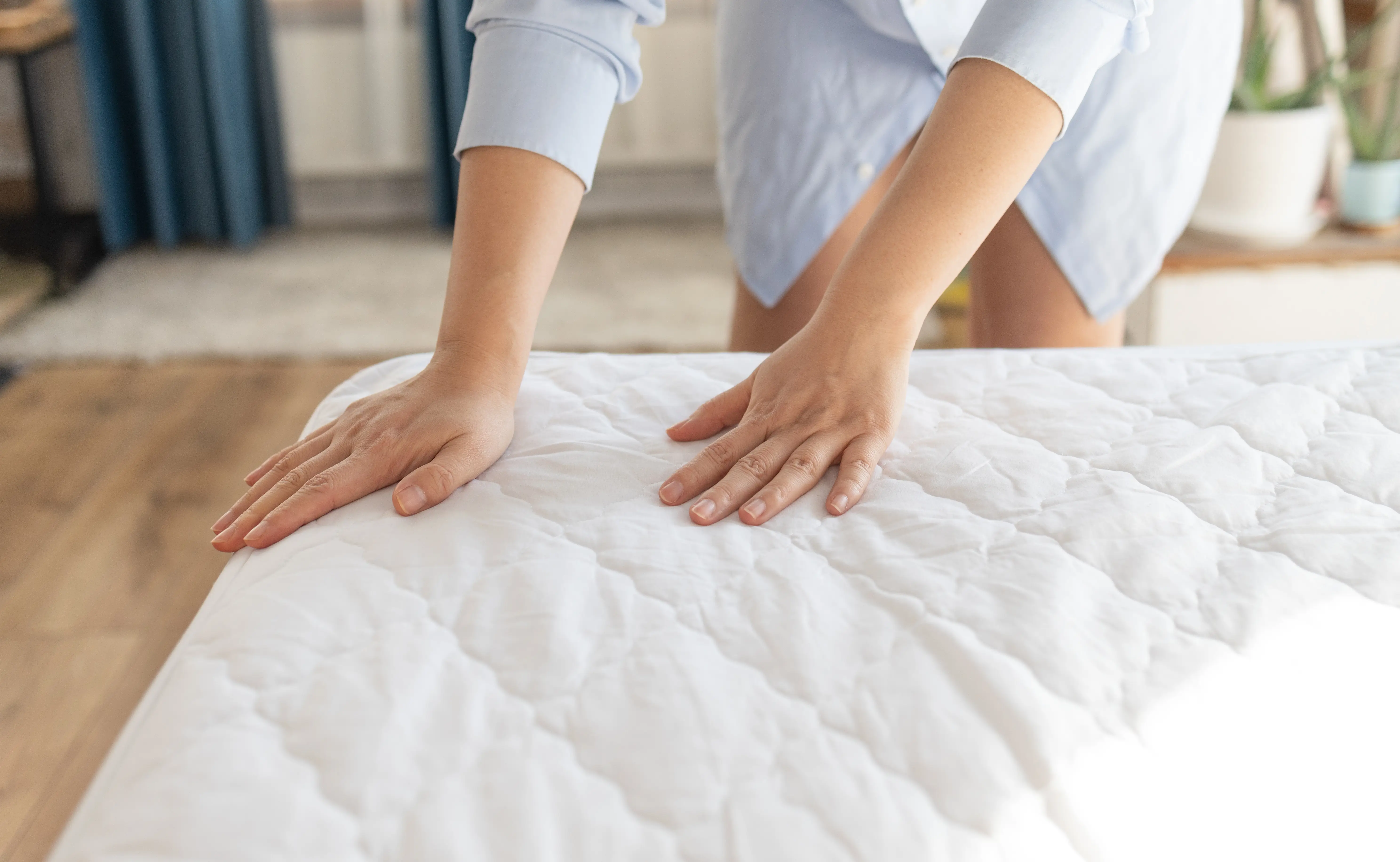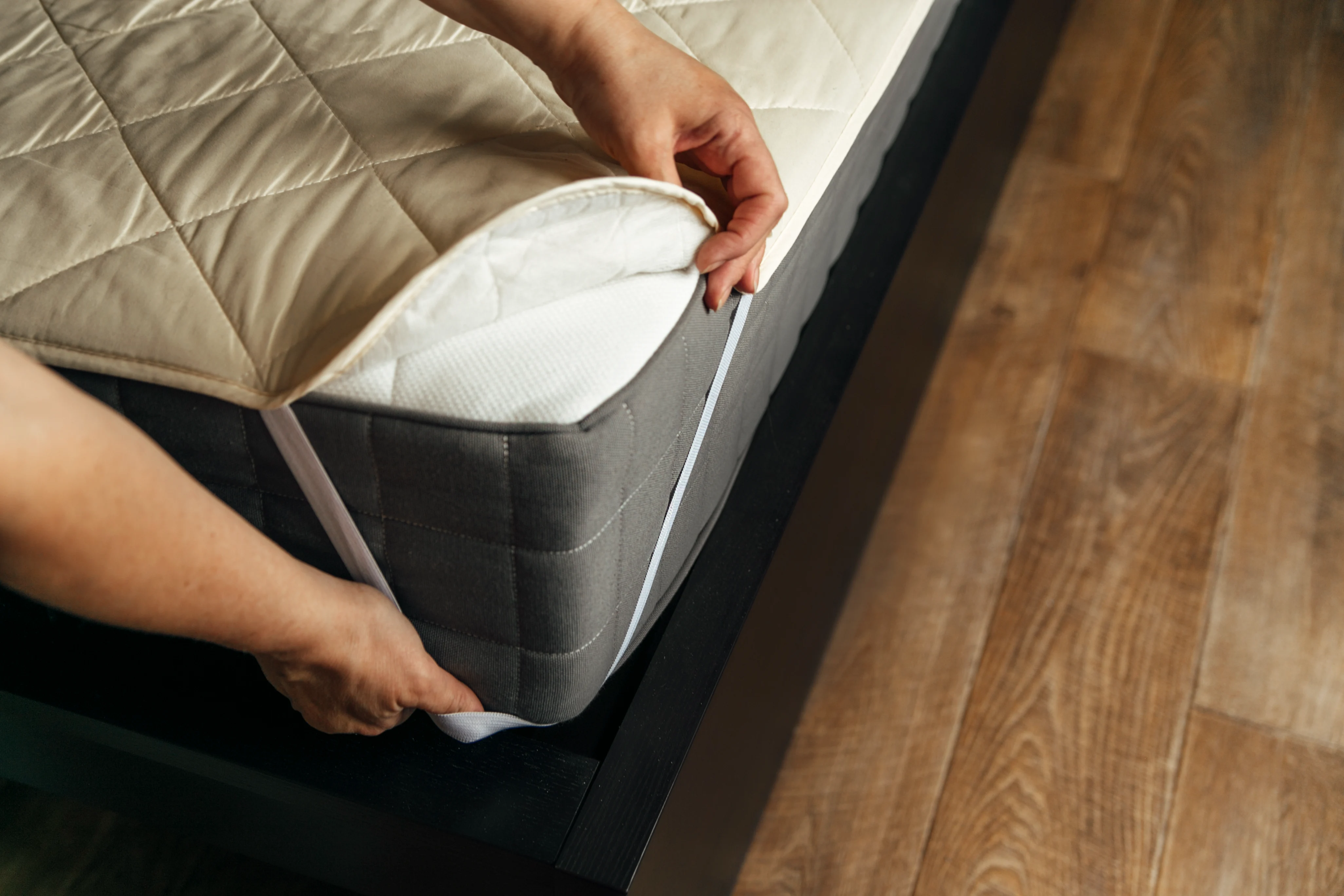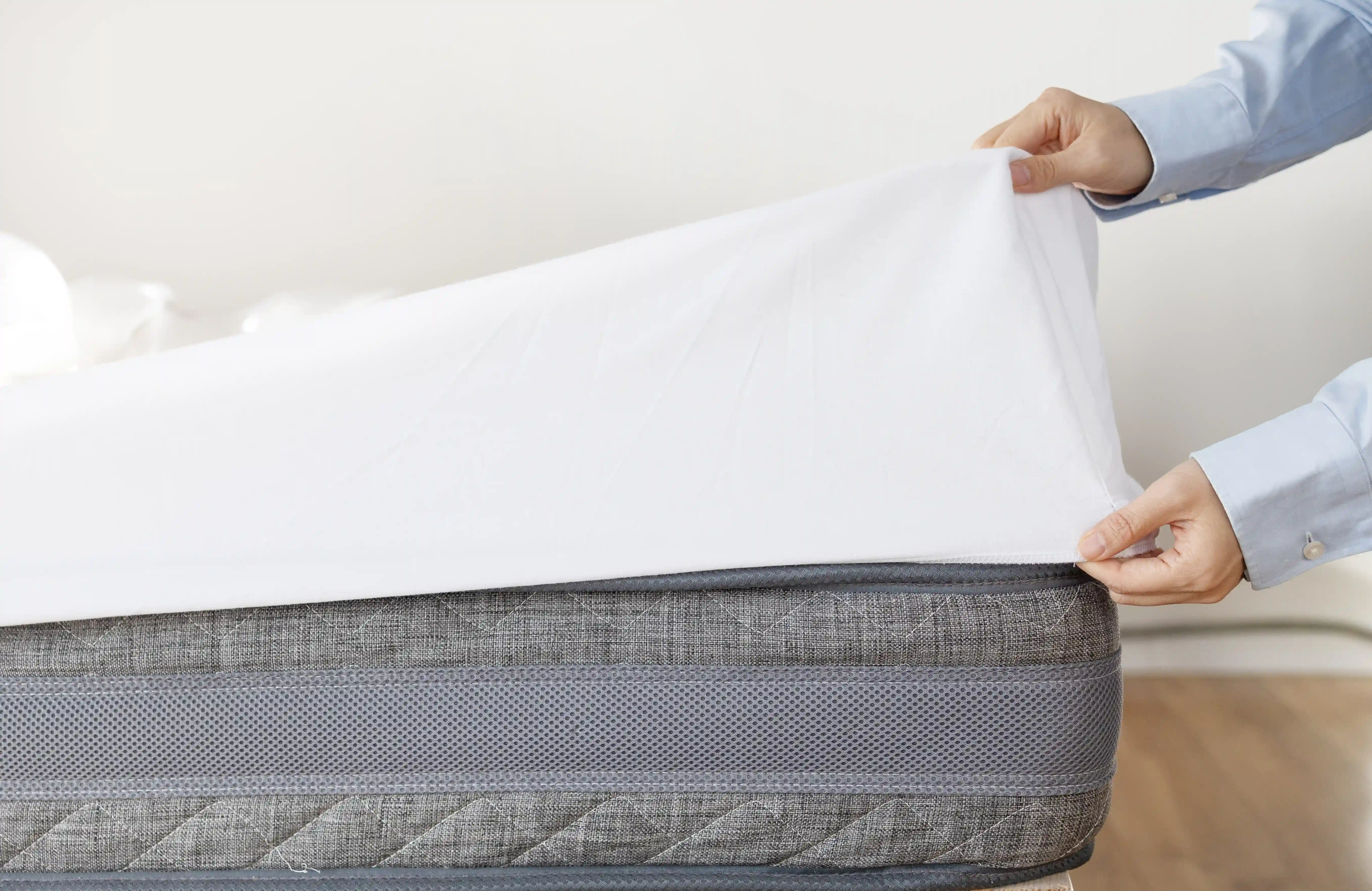Investing in a quality mattress is a pivotal decision for anyone prioritizing a good night's sleep. However, whether a mattress protector is worth investing in or not is a question that often arises.
While some may view it as an unnecessary accessory, the benefits of using a mattress protector extend far beyond mere aesthetics.
In this article, we will explore the types of mattress protectors, the essential reasons why incorporating them into your bedding routine may be more important, and the potential drawbacks of using them.
What Is a Mattress Protector?

A mattress protector is a specialized bedding accessory designed to safeguard your mattress from various forms of damage, including spills, stains, and allergens. Typically made from waterproof materials, it acts as a barrier that prevents liquids from seeping into the mattress, thereby extending its lifespan.
Additionally, many mattress protectors are equipped with dust mite- and allergen-resistant properties, enhancing the overall cleanliness of your sleeping environment. Investing in a quality mattress protector is essential for maintaining both the integrity and hygiene of your mattress and ensuring a healthier sleeping experience.
Types of Mattress Protectors
When it comes to preserving the lifespan of your mattress, choosing the right mattress protector is essential. There are several types of mattress protectors available on the market, each designed to cater to specific needs and preferences.
Understanding the differences between cotton, vinyl, waterproof, and quilted mattress protectors can help consumers make informed decisions based on their requirements.
- Cotton: Cotton mattress protectors are among the most popular options available. They offer a natural, breathable fabric that is soft and durable, making them comfortable for sleeping. Cotton protectors are known for their ability to wick away moisture, helping to regulate temperature during sleep.
- Vinyl: The design of vinyl mattress protectors prioritizes durability and protection. These protectors feature a waterproof barrier that effectively prevents liquids from penetrating the mattress. This makes them particularly suitable for households with children or pets, as they can withstand spills and accidents without compromising the integrity of the mattress.
- Waterproof: Waterproof mattress protectors combine the benefits of both cotton and vinyl. They typically feature a top layer made from cotton or a cotton blend for comfort and breathability while incorporating a waterproof backing made from materials like polyurethane or vinyl. This hybrid design allows for protection against spills and allergens while maintaining a soft sleeping surface.
- Quilted: Quilted mattress protectors provide an additional layer of comfort and cushioning on top of the mattress. These protectors are usually filled with a soft material and feature a quilted design that enhances their aesthetic appeal while also providing extra padding. This type of protector can help reduce wear and tear on the mattress while also adding a plush layer that enhances the overall sleeping experience.
Check out our best list for The Best Mattress Protectors.
What does a mattress protector actually do?

A mattress protector is an essential accessory for any bed, serving multiple critical functions that enhance both the longevity of the mattress and the overall sleeping experience.
Investing in a reliable mattress protector is not just about immediate protection; it is an essential step toward ensuring long-term well-being in your sleeping environment.
Shields Against Spills and Stains
One of the primary roles of a mattress protector is to shield against spills and stains. Accidents are inevitable, whether from drinks, food, or even bodily fluids.
A quality mattress protector acts as a barrier, preventing liquids from penetrating the mattress material, which can lead to unpleasant odors, mildew, and mold growth.
This protective layer not only preserves the aesthetic quality of the mattress but also safeguards its structural integrity, ensuring that it remains comfortable and supportive for years to come.
Protects from Dust Mites, Bedbugs, and Allergens
Dust mites are microscopic creatures that thrive in bedding environments, feeding on dead skin cells and contributing to common allergic reactions such as sneezing, itching, and asthma symptoms.
A good mattress protector is often made from materials that are hypoallergenic and impermeable to these pests, effectively blocking their entry and reducing their population.
In the case of bedbugs, which can cause severe discomfort and distress, a mattress protector provides a line of defense that makes it more difficult for these pests to infest your sleeping environment. By creating a barrier against allergens and pests, a mattress protector promotes better sleep hygiene and overall health.
Extends Mattress Lifespan
The lifespan of your mattress is another area where a mattress protector proves invaluable. Mattresses are a significant investment, often costing hundreds or even thousands of dollars.
A protector helps to extend the life of this investment by minimizing wear and tear. It acts as a first line of defense against physical damage, such as scratches or indentations, caused by everyday use.
By reducing the accumulation of dust, allergens, and moisture, a mattress protector can also help maintain the materials and construction of the mattress itself.
Hygiene Benefits
Hygiene benefits cannot be overstated when discussing the importance of a mattress protector. The human body naturally sheds skin cells and secretes moisture during sleep, creating an environment that can foster bacterial growth if not properly managed.
A mattress protector simplifies maintenance by allowing for easy removal and washing. Most protectors are machine washable, making it simple to keep your sleeping environment clean and hygienic with minimal effort.
Maintains Warranty Validity
Using a mattress protector helps maintain warranty validity. Many mattress manufacturers require that specific care guidelines be followed in order for warranties to remain valid.
Failing to use a protector could result in voiding the warranty if damage occurs due to spills or stains.
By adhering to these guidelines through the use of a mattress protector, consumers can safeguard their investment and ensure they are covered in case of any defects or issues that may arise.
Easier to Wash Than a Mattress
Cleaning a mattress can be an arduous task, often requiring professional services or intense manual labor. In contrast, a mattress protector is much easier to wash and maintain.
Most protectors are machine washable, allowing for simple upkeep and ensuring that they remain fresh and clean over time. This ease of maintenance encourages regular washing, contributing further to enhanced hygiene in the bedroom.
Drawbacks of Using a Mattress Protector
While mattress protectors are generally lauded for their ability to provide a barrier against allergens, spills, and general wear, they do come with certain drawbacks that may affect the overall sleeping experience.
Can Trap Heat
Many mattress protectors, particularly those made from synthetic materials, can create an insulating layer that doesn't breathe well.
This can lead to an uncomfortable sleeping environment, especially for individuals who tend to sleep hot or live in warmer climates.
Consequently, the very function of a mattress protector, which is to enhance comfort and hygiene, can paradoxically result in discomfort due to excessive heat retention.
May Add Noise
Some protectors are made from materials that can crinkle or rustle when one shifts during the night. This noise can be disruptive for both the individual using the mattress and their partner, leading to disturbances in sleep quality.
While many manufacturers have addressed this issue by using quieter materials, it remains an important factor for consumers to consider when selecting a protector. A noisy mattress protector can compromise the peaceful environment necessary for restorative sleep.
Might Alter the Feel of the Mattress
Many people invest in high-quality mattresses with specific firmness levels and comfort features. Adding a layer of material can change how these features are perceived, potentially leading to an experience that deviates from what was originally intended.
For example, a thick or padded protector might make a firm mattress feel softer than desired, which could be particularly problematic for those who rely on their mattress to maintain proper spinal alignment during sleep.
Needs Regular Washing
While many people appreciate the protective benefits of a mattress protector, they also require consistent maintenance to ensure hygiene and effectiveness.
Depending on the material and usage, protectors should ideally be washed every few weeks or months. This regular upkeep can be cumbersome for some individuals, especially those with busy lifestyles or limited access to laundry facilities.
Who should consider buying a mattress protector?

A mattress protector is an important accessory for various groups of people. Whether for health reasons related to allergies or asthma, family dynamics involving young children or pets, lifestyle habits like eating in bed, protecting new mattresses, accommodating hot sleepers, or preserving financial investments.
There is a compelling case for nearly everyone to consider adding this layer of protection to their sleep environment.
People with Allergies or Asthma
Individuals with allergies or asthma should seriously consider purchasing a mattress protector. These protectors are designed to shield against allergens such as dust mites, mold, bedbugs, and pet dander, which can exacerbate respiratory issues.
By creating a barrier between the individual and these irritants, a mattress protector can significantly enhance sleep quality and overall health for those prone to allergic reactions or asthma attacks.
Families with Young Children or Pets
Families with young children or pets represent another demographic that can greatly benefit from a mattress protector. Young children are prone to spills, accidents, and general messiness, while pets may bring in dirt and allergens from outdoors.
A mattress protector acts as a safeguard against stains and odors, ensuring that the mattress remains clean and hygienic despite the inevitable mishaps that come with family life. Additionally, many protectors are machine washable, making them easy to maintain and replace as needed.
Anyone Who Eats or Drinks in Bed
For those who enjoy late-night snacks or beverages in bed, a mattress protector is an invaluable asset. Accidental spills can lead to long-lasting stains, unpleasant odors, and even potential damage to the mattress itself.
A quality mattress protector offers an additional layer of security against these mishaps, enabling individuals to relax and enjoy their nighttime routines without worrying about ruining their sleeping surface.
Anyone with a New Mattress
Individuals who have recently invested in a new mattress should also consider purchasing a mattress protector. A new mattress is often a significant financial investment, and protecting it from wear and tear is key to preserving its comfort and durability over time.
A mattress protector acts as a shield against spills, stains, and other forms of damage that can occur during its lifespan. By taking this proactive measure, consumers can ensure that their investment remains in optimal condition for years to come.
Hot Sleepers or Those Who Suffer from Night Sweats
Hot sleepers or those who suffer from night sweats will find significant benefits in using a breathable mattress protector.
Many modern protectors are designed with temperature-regulating technology or moisture-wicking fabrics that help keep the sleeper cool and comfortable throughout the night.
This feature is particularly important for individuals prone to overheating during sleep or looking for cooling features, as it minimizes discomfort and promotes restorative rest.
Those Wanting to Preserve Their Investment
Anyone looking to preserve their investment should consider buying a mattress protector. A high-quality mattress can last anywhere from seven to ten years, but without proper care, this lifespan can be significantly reduced.
By utilizing a mattress protector, consumers can extend the life of their mattresses while also enhancing their overall sleep experience. Protecting this essential piece of furniture ensures comfort and helps maintain the value of the investment over time.
Choosing the Right Mattress Protector
Choosing the right mattress protector is important because it guarantees the longevity and hygiene of your mattress.
By investing in the right mattress protector, you enhance your sleeping experience while safeguarding your investment in a good night's rest.
Key Features to Look For
When selecting a mattress protector, it is essential to prioritize features that enhance both comfort and durability.
Taking the time to evaluate these features will ultimately lead to an informed decision that enhances your sleeping environment while preserving the longevity of your mattress.
- Waterproof Backing: A mattress protector with a waterproof layer acts as a barrier against spills, stains, and bodily fluids, safeguarding the integrity of your mattress. This feature is particularly beneficial for households with children or pets, as accidents are more likely to occur. Furthermore, a waterproof backing can prevent dust mites and other allergens from penetrating the mattress, thus contributing to a healthier sleeping environment.
- Breathable Fabric: Breathability is crucial for maintaining a comfortable sleeping temperature throughout the night. Protectors made from breathable materials help regulate heat and moisture, which can prevent overheating and promote a more restful sleep experience. Additionally, breathable fabrics often contribute to enhanced airflow, reducing the likelihood of mold and mildew growth in humid conditions. Therefore, choosing a mattress protector with this feature ensures comfort while also extending the lifespan of your mattress.
- Hypoallergenic Materials: Many individuals suffer from allergies that can be aggravated by dust mites, pet dander, and other allergens that accumulate in mattresses over time. A hypoallergenic mattress protector acts as a shield against these irritants, providing a cleaner sleeping surface. By incorporating hypoallergenic materials into the design, manufacturers help reduce allergic reactions and promote better overall health for sleepers. This aspect is especially vital for individuals with asthma or other respiratory conditions.
- Deep Pockets or Elastic Edges: The design of the mattress protector should also be taken into account. Deep pockets or elastic edges are essential for ensuring that the protector fits snugly over your mattress. A well-fitted protector enhances its protective capabilities and prevents slipping or bunching during use, which can disrupt sleep. Deep pockets accommodate thicker mattresses, while elastic edges secure the protector in place, offering peace of mind that your investment is adequately protected.
- OEKO-TEX® Certified: It is essential to look for a mattress protector that is OEKO-TEX® certified. This certification signifies that the materials used in the product have been tested for harmful substances and produced in an environmentally friendly manner. An OEKO-TEX® certified mattress protector ensures that you are making a safe choice for both your health and the planet. By selecting products that adhere to these rigorous standards, consumers can feel confident that they are investing in quality items.
Alternatives to a Mattress Protector
When considering alternatives to a mattress protector, mattress pads and fitted sheets emerge as viable options that offer varying levels of protection and comfort.
Both options contribute to a better sleeping environment while allowing for easy maintenance and cleaning. Ultimately, whether one opts for a mattress pad or fitted sheets will depend on personal preferences and specific needs in terms of comfort and protection.
Mattress Pads
Mattress pads serve as an additional layer of cushioning on top of the mattress. They enhance the softness of the bed and provide a degree of protection against spills, stains, and general wear and tear.
Many mattress pads are designed with materials that can wick away moisture, making them particularly beneficial for those who sweat during sleep or have allergies.
By incorporating a mattress pad, individuals can prolong the lifespan of their mattress while enjoying a more comfortable sleeping surface.
Fitted Sheets
Fitted sheets, on the other hand, are another alternative that can help maintain the cleanliness of the mattress. While they do not provide the same level of protection as mattress pads or dedicated mattress protectors, they serve as a primary barrier against dust, dirt, and allergens.
Choosing high-quality fitted sheets made from breathable fabrics can also enhance sleep quality by regulating temperature throughout the night.
Utilizing a combination of mattress pads and fitted sheets can be an effective solution for those looking to balance comfort and protection without investing in a traditional mattress protector.
Mattress Toppers
Mattress toppers serve as viable alternatives to traditional mattress protectors, providing an additional layer of comfort and support.
Designed to enhance the sleeping experience, these toppers can alleviate pressure points and improve spinal alignment.
Unlike mattress protectors, which primarily shield against spills and allergens, toppers focus on enhancing the overall feel of the mattress. Available in various materials, such as memory foam, latex, and gel, they cater to diverse sleep preferences.
Know more about the Different Sizes of Mattress Toppers .
FAQs
What’s the difference between a mattress protector and a mattress pad?
A mattress protector is primarily designed to safeguard the mattress from spills, stains, and allergens. It acts as a barrier against dust mites and bedbugs, thus prolonging the life of the mattress. In contrast, a mattress pad offers additional comfort and cushioning, often featuring materials like memory foam or cotton.
Is a mattress protector noisy or uncomfortable?
Most modern mattress protectors are crafted from soft, breathable materials that minimize noise, ensuring a quiet sleeping experience. Additionally, they are engineered to fit snugly over the mattress, reducing any chances of discomfort.
Do I need a mattress protector if I already have a high-quality mattress?
Even the best mattresses can be susceptible to spills, stains, dust mites, and allergens. A mattress protector serves as a mattress encasement and bedding protection, as well as preserving the integrity of your mattress and extending its lifespan.
How often should I wash a mattress protector?
To maintain optimal hygiene and prolong the lifespan of your mattress protector, it is recommended to wash it every one to three months.
Conclusion
The choice to use a mattress protector is not just about added comfort; it is a proactive measure that safeguards your investment and enhances your sleep environment.
By creating a protective barrier, a mattress protector can significantly extend the lifespan of your mattress while ensuring it remains clean and hygienic. For those who suffer from allergies or have children and pets, the benefits become even more pronounced.
Thus, when contemplating whether you really need a mattress protector, consider the long-term advantages it offers for both your health and the durability of your mattress. Ultimately, a small investment in a quality mattress protector can lead to substantial returns in sleep quality and mattress longevity.
Dom Abraham
As the lead content writer at Sleepiverse. Dom pours his heart into writing mattress reviews, bedding product reviews, and medically-reviewed health articles. Dom is from Portugal and likes to spend his free time writing on the beach as it gives him a sense of comfort. Aside from writing mattress reviews in front of the soothing beach view, Dom likes to experiment with new amazing food ideas.


